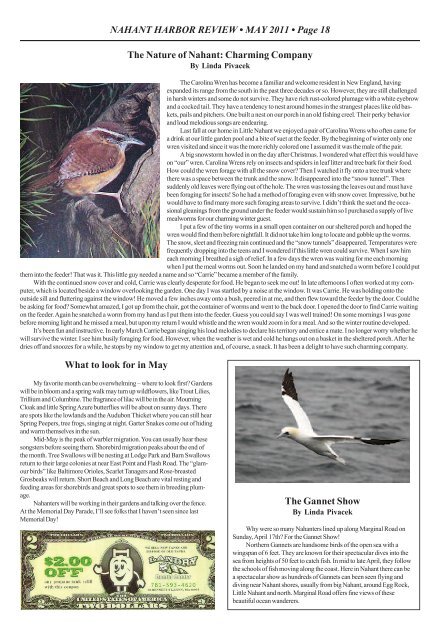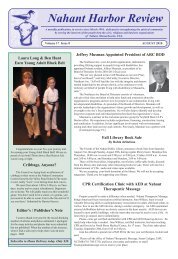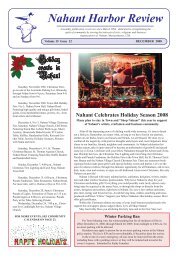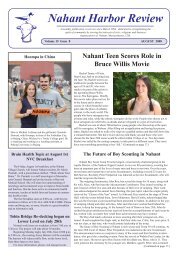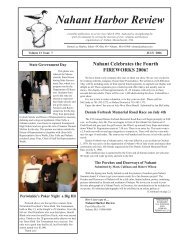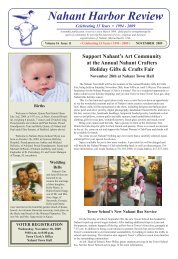2011 MAY PM.pmd - Nahant, Massachusetts USA
2011 MAY PM.pmd - Nahant, Massachusetts USA
2011 MAY PM.pmd - Nahant, Massachusetts USA
- No tags were found...
Create successful ePaper yourself
Turn your PDF publications into a flip-book with our unique Google optimized e-Paper software.
NAHANT HARBOR REVIEW • <strong>MAY</strong> <strong>2011</strong> • Page 18The Nature of <strong>Nahant</strong>: Charming CompanyBy Linda PivacekThe Carolina Wren has become a familiar and welcome resident in New England, havingexpanded its range from the south in the past three decades or so. However, they are still challengedin harsh winters and some do not survive. They have rich rust-colored plumage with a white eyebrowand a cocked tail. They have a tendency to nest around homes in the strangest places like old baskets,pails and pitchers. One built a nest on our porch in an old fishing creel. Their perky behaviorand loud melodious songs are endearing.Last fall at our home in Little <strong>Nahant</strong> we enjoyed a pair of Carolina Wrens who often came fora drink at our little garden pool and a bite of suet at the feeder. By the beginning of winter only onewren visited and since it was the more richly colored one I assumed it was the male of the pair.A big snowstorm howled in on the day after Christmas. I wondered what effect this would haveon “our” wren. Carolina Wrens rely on insects and spiders in leaf litter and tree bark for their food.How could the wren forage with all the snow cover? Then I watched it fly onto a tree trunk wherethere was a space between the trunk and the snow. It disappeared into the “snow tunnel”. Thensuddenly old leaves were flying out of the hole. The wren was tossing the leaves out and must havebeen foraging for insects! So he had a method of foraging even with snow cover. Impressive, but hewould have to find many more such foraging areas to survive. I didn’t think the suet and the occasionalgleanings from the ground under the feeder would sustain him so I purchased a supply of livemealworms for our charming winter guest.I put a few of the tiny worms in a small open container on our sheltered porch and hoped thewren would find them before nightfall. It did not take him long to locate and gobble up the worms.The snow, sleet and freezing rain continued and the “snow tunnels” disappeared. Temperatures werefrequently dropping into the teens and I wondered if this little wren could survive. When I saw himeach morning I breathed a sigh of relief. In a few days the wren was waiting for me each morningwhen I put the meal worms out. Soon he landed on my hand and snatched a worm before I could putthem into the feeder! That was it. This little guy needed a name and so “Carrie” became a member of the family.With the continued snow cover and cold, Carrie was clearly desperate for food. He began to seek me out! In late afternoons I often worked at my computer,which is located beside a window overlooking the garden. One day I was startled by a noise at the window. It was Carrie. He was holding onto theoutside sill and fluttering against the window! He moved a few inches away onto a bush, peered in at me, and then flew toward the feeder by the door. Could hebe asking for food? Somewhat amazed, I got up from the chair, got the container of worms and went to the back door. I opened the door to find Carrie waitingon the feeder. Again he snatched a worm from my hand as I put them into the feeder. Guess you could say I was well trained! On some mornings I was gonebefore morning light and he missed a meal, but upon my return I would whistle and the wren would zoom in for a meal. And so the winter routine developed.It’s been fun and instructive. In early March Carrie began singing his loud melodies to declare his territory and entice a mate. I no longer worry whether hewill survive the winter. I see him busily foraging for food. However, when the weather is wet and cold he hangs out on a basket in the sheltered porch. After hedries off and snoozes for a while, he stops by my window to get my attention and, of course, a snack. It has been a delight to have such charming company.What to look for in MayMy favorite month can be overwhelming – where to look first? Gardenswill be in bloom and a spring walk may turn up wildflowers, like Trout Lilies,Trillium and Columbine. The fragrance of lilac will be in the air. MourningCloak and little Spring Azure butterflies will be about on sunny days. Thereare spots like the lowlands and the Audubon Thicket where you can still hearSpring Peepers, tree frogs, singing at night. Garter Snakes come out of hidingand warm themselves in the sun.Mid-May is the peak of warbler migration. You can usually hear thesesongsters before seeing them. Shorebird migration peaks about the end ofthe month. Tree Swallows will be nesting at Lodge Park and Barn Swallowsreturn to their large colonies at near East Point and Flash Road. The “glamourbirds” like Baltimore Orioles, Scarlet Tanagers and Rose-breastedGrosbeaks will return. Short Beach and Long Beach are vital resting andfeeding areas for shorebirds and great spots to see them in breeding plumage.<strong>Nahant</strong>ers will be working in their gardens and talking over the fence.At the Memorial Day Parade, I’ll see folks that I haven’t seen since lastMemorial Day!The Gannet ShowBy Linda PivacekWhy were so many <strong>Nahant</strong>ers lined up along Marginal Road onSunday, April 17th? For the Gannet Show!Northern Gannets are handsome birds of the open sea with awingspan of 6 feet. They are known for their spectacular dives into thesea from heights of 50 feet to catch fish. In mid to late April, they followthe schools of fish moving along the coast. Here in <strong>Nahant</strong> there can bea spectacular show as hundreds of Gannets can been seen flying anddiving near <strong>Nahant</strong> shores, usually from big <strong>Nahant</strong>, around Egg Rock,Little <strong>Nahant</strong> and north. Marginal Road offers fine views of thesebeautiful ocean wanderers.


